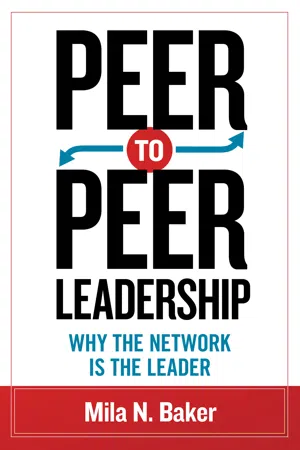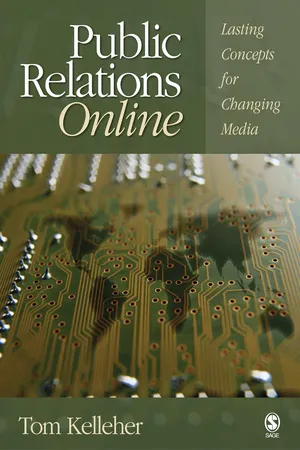Peer to Peer Network
A peer-to-peer network is a decentralized communication model where each participant has the same abilities and responsibilities. In this type of network, each node can act as both a client and a server, allowing for direct communication and resource sharing between individual devices without the need for a central server. This architecture is commonly used for file sharing, distributed computing, and communication applications.
5 Key excerpts on "Peer to Peer Network"
- eBook - ePub
Peer-to-Peer Leadership
Why the Network Is the Leader
- Mila N. Baker(Author)
- 2014(Publication Date)
- Berrett-Koehler Publishers(Publisher)
...A peer-to-peer network model is built around the nexus of interaction between people and technology, where the person is the communicator and technology is the connector. Individuals send and receive information, while technology—in the form of data, analysis software, and other collaboration tools—provides the structure for the workflow and for the interactivity that enables everyone to share and receive information. The organization of data in a peer-to-peer network enables the efficient and effective flow of information from where it resides to where it is needed. Information can be created, extended, added to, revised, and published in real time, and it can also be used for more effective and efficient decision making, problem solving, and timeliness in completing work assignments across an enterprise. With peer-to-peer architecture, the flow of information within an organization changes and becomes more adaptive and more flexible in terms of meeting communication needs. Real-time communication increases, and organizations can reap significant benefits from the ability to transmit information quickly and efficiently. The rapid flow of information also increases transparency, accelerates learning among new hires, informs others of standards and governance, and expands access to other networks. The flow of information in peer-to-peer networks also allows us to examine human interaction patterns and correlations among data. It provides information on which peers have resources and information available to share, and where the information can be found. The network can continue to generate assets and resources as they are consumed. The network is the leader, and the network provides the connectivity needed for sending and receiving information that can be shared and used by all. Summary Closed-source business models have been prevalent in the past, and much of the power held within an organization is based on controlling and disseminating information...
- eBook - ePub
Business
The Ultimate Resource
- Bloomsbury Publishing(Author)
- 2011(Publication Date)
...Exploring Peer-to-peer (P2P) Commerce GETTING STARTED Peer-to-peer (P2P) embraces the networking capabilities of the Internet. It allows people to share and publish resources directly, and allows the unused processing capability of computers to be shared and used productively. While the concept of peer-to-peer has in fact been around for many years, it has gained a new lease of life with the advent of the Internet. The peer-to-peer model became particularly well-known in connection with the original Napster music swapping service and later Skype, which provides high-quality voice calls over the Internet. FAQs What exactly is peer-to-peer? Peer-to-peer puts every computer on an equal footing, in that every computer can be both a publisher and consumer of information. The traditional model on the Web is the client–server one. The client is a computer and browser that is able only to receive/consume information. The server, on the other hand, serves/publishes information on a Web site. Peer-to-peer makes a computer both a server and client. What are examples of peer-to-peer? Perhaps the best-known example of peer-to-peer is Skype (www.skype.com). Skype allows people to make a voice call directly to any other Skype user in the world. There are also a plethora of P2P file-sharing programs. File-sharing programs generally work as follows: Person A could search for and download music from Person B’s computer, while Person B could search for and download music from Person A’s computer...
- eBook - ePub
The Connect Effect
Building Strong Personal, Professional, and Virtual Networks
- Michael Dulworth(Author)
- 2008(Publication Date)
- Berrett-Koehler Publishers(Publisher)
...91 6 Networking Peer-to-Peer We’re going to shift gears a bit now. We’ve been discussing ways to develop your networking skills and build your network. In the next few chapters, we’re going to focus on different types of networks. The peer-to-peer networks discussed in this particular chapter bridge organizational boundaries. Chapter 7 will focus on internal organization networks, and chapter 8 will discuss communities based on a common concern or passion: communities of practice. While, by definition, peer-to-peer networks lack an important dimension of diversity (everyone has the same occupation), the trade-off is well worth it. As Jim Bolt, wrote in a recent article in Fast Company, “The central idea behind the effectiveness of peer-to-peer networks is this: We all learn better, trust more, and gravitate to the shared experiences of people at our level and in circumstances similar to ours. And, there is incredible value in being able to tap into the collective experience of a group of trusted peers.” 4 When computer techies talk about peer-to-peer networks, they are referring to computer networks with no hierarchical structure: every computer is on the same footing. It’s the same 92 when it comes to people: in your peer-to-peer network, you are with your equals. One reason that peer-to-peer networks are so effective is that they create a secure, open environment that helps accelerate learning and development. The network becomes a safe harbor for participants to freely discuss issues and challenges of individual and organizational importance with peers in organizations who have very similar positions and responsibilities. If you belong to a professional association such as the American Marketing Association, the American Society for Training and Development, or the Public Relations Society of America, you may already be a member of a peer-to-peer network...
- eBook - ePub
Public Relations Online
Lasting Concepts for Changing Media
- Thomas A. Kelleher(Author)
- 2006(Publication Date)
- SAGE Publications, Inc(Publisher)
...Now granted, when those shared files contain copyrighted material, the networks run into legal issues, which is what led to the downfall of Napster and WinMX, but the concept of people working in peer-to-peer networks in the legitimate and productive exchange of original resources is becoming more and more prevalent online. Yale law professor Yochai Benkler (2006) has suggested that the general characteristics of peer-to-peer networks are changing the very nature of “information production fields”: The material requirements for effective information production and communication are now owned by numbers of individuals several orders of magnitude larger than the number of owners of the basic means of information production and exchange a mere two decades ago.… We are beginning to see the expansion of this model not only to our core software platforms, but beyond them into every domain of information and cultural production…from peer production of encyclopedias, to news and commentary, to immersive entertainment. (pp. 4–5) Whereas computing power and digital resources are concentrated on servers in server-side online operations, peer-to-peer networks work with resources that are more evenly distributed among the participants. This potential for more balance in the communication process makes peer-to-peer technology a useful metaphor for online public relations. Whereas public relations books and academic articles of the 1980s focused most often on tools and tips for one-way communication tactics such as publicity, corporate advertising, audiovisual techniques, and effects-based communication efforts, public relations scholarship in the new millennium is just as likely to cover symmetrical models of communication, women’s studies, diversity, and negotiation (Botan & Taylor, 2004)...
- eBook - ePub
Cybercrime
Investigating High-Technology Computer Crime
- Robert Moore(Author)
- 2014(Publication Date)
- Routledge(Publisher)
...The networking protocols that make up the Internet were designed to make the sharing of files and resources among computers easier. In fact, it was this desire to make sharing of information easier that led researchers at the Massachusetts Institute of Technology (MIT), along with the Defense Advanced Research Projects Agency (of the U.S. Department of Defense) to develop the early forerunner of the Internet, the ARPANET (Advanced Research Projects Agency Network). Even though the P2P networking protocols have become associated with criminal copyright infringement, it is worth noting that there are still many legitimate uses for this software. The problem is that few people actually use the software for any legitimate business-related purposes. Because of the media frenzy surrounding the illegal use of the software, today peer-to-peer software has become synonymous with the violation of copyright law and the theft of intellectual property. Today, few people are even aware that the software was developed for legal purposes; the software is better known as a tool for trading music, movies, software, pornography, and other digital files. The association of peer-to-peer software with intellectual property theft is likely tied to the creation and release of the Napster software, considered to be the originator of digital file sharing. Napster was developed in the late 1990s by a college dropout who was a digital music fan. The software’s developer was 19 years old at the time he wrote the software program, and he wrote the software as a means of trading music files that were stored on his personal computer. Napster was the first file-sharing program to take advantage of the fact that audio files, and more specifically music files, were being compressed through the use of a new algorithm— the MP3 algorithm...




